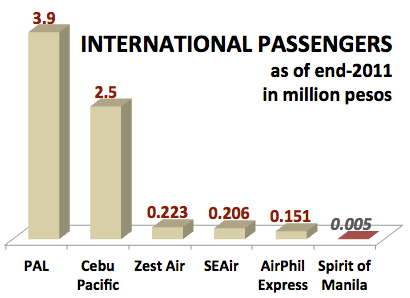SUMMARY
This is AI generated summarization, which may have errors. For context, always refer to the full article.
MANILA, Philippines – As the Philippine aviation market intensifies with current players beefing up their fleet and financial arsenal, local carrier South East Asian Airlines (SEAir) is proceeding with its own expansion plans.
On late Monday, April 16, its foreign partner, Singapore-based Tiger Airways, announced that it plans to hike its stake in Seair to 40% — the maximum level foreigners can own in local transportation firm — from the current 32.5%.
“[Tiger Airways] plans to purchase a 40% stake in [SEAir] for US$7 million,” Tiger told the Singapore Stock Exchange.
Tiger added that the 2 parties have revised their term sheet, which was originally signed in February 2011, around the time Malaysia-based AirAsia was waiting for permits to start flying to local destinations through a local unit.
When the first agreement with SEAir was sealed, Tiger already infused US$6 million. The 2nd tranch will further support SEAir’s bid to expand its domestic and international operations.
SEAir is the 5th largest among 6 local carriers in a market dominated by giants like Philippine Airlines (PAL), Cebu Pacific, AirPhil Express, as well as Zest Air. Only Spirit of Manila beats Seair to the bottom.


Recently, 2 landmark events happened that could pose a threat to SEAir.
One, the holding firms of legacy carrier PAL have sealed a $500 million deal with San Miguel Corp, the country’s largest conglomerate.
The Centre for Asia Pacific Aviation has noted that this deal will likely boost PAL’s unit, AirPhil Express, since most of the growth in the airline industry is coming from low-cost operations rather than PAL’s challenged business model as a legacy airline.
AirPhil Express and SEAir are rivals in the low-cost carrier market, both here and abroad.
With San Miguel’s entry, AirPhil Express and PAL are expected to give the likes of SEAir a run for their money.
AirAsia Philippines
The 2nd threat to SEAir-Tiger is AirAsia Philippines, which commenced local operations in March.
Unlike AirAsia Berhad, which is barred from ferrying passengers to Philippine destinations, AirAsia Philippines, which is 60% owned by Filipino businessmen, can mount flights to local airports.
AirAsia Philippines hits SEAir in different fronts. The newest airline in the country is operating from its hub in Clark airport, around 80 kilometers north of Metro Manila, the capital, and has an open skies policy.
SEAir is also operating most of its flights at the sprawling aviation complex in Clark, with flights bound for the tourist haven of Boracay island accounting for bulk of the traffic.
Given AirAsia Philippines’ current and target routes, Seair’s flights from Clark to to Boracay, Davao and Palawan, another tourist destination, face competition.
AirAsia Philippines benefits from traffic that AirAsia’s network of flights feed into Clark. For example, some, if not most, passengers onboard Kuala Lumpur-Clark flight would take the connecting Clark-Boracay flight.
The Tiger-SEAir partnership is designed to provide a similar feeder-arrangement.
Tiger is the low-cost carrier unit of legacy carrier Singapore Airline, which has an extensive regional and global route network that SEAir can benefit from, especially after the Civil Aeronautics Board (CAB) recently lifted the ban to allow the two Tiger-leased aircraft of SEAir to fly to Cebu and Davao.
As an added feature of the deal between the Singaporean and Philippine carriers, SEAir can market Tiger-branded flights on international routes.
SEAir has an application to serve from Clark 3 Malaysian destinations – Kuala Lumpur, Kuching and Kota Kinabalu. “If launched, the new Malaysian routes would further intensify competition between SEAir-Tiger and AirAsia as Malaysia AirAsia already operates daily flights to Clark from Kota Kinabalu and Kuala Lumpur,” CAPA noted.
While challenges and threats abound for SEAir, the timely announcement of Tiger’s new investment round is likely meant to show that SEAir should not be counted out yet. – Rappler.com
Add a comment
How does this make you feel?
There are no comments yet. Add your comment to start the conversation.